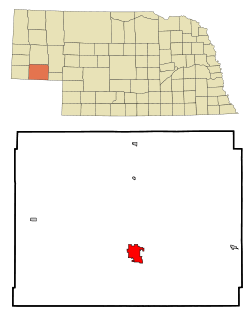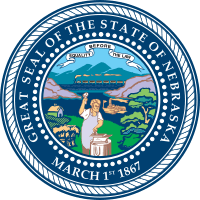Sidney, Nebraska
Sidney is a city in and the county seat of Cheyenne County, Nebraska, United States.[7] This city is nine miles north from the Colorado state line. The population was 6,757 at the 2010 census.
Sidney, Nebraska | |
|---|---|
Carnegie library | |
 Location within Cheyenne County and Nebraska | |
| Coordinates: 41°8′22″N 102°58′42″W | |
| Country | United States |
| State | Nebraska |
| County | Cheyenne |
| Government | |
| • Mayor | Roger Gallaway[1] |
| • City Manager | Ed Sadler[2] |
| Area | |
| • Total | 7.49 sq mi (19.39 km2) |
| • Land | 7.49 sq mi (19.38 km2) |
| • Water | 0.00 sq mi (0.00 km2) |
| Elevation | 4,088 ft (1,246 m) |
| Population | |
| • Total | 6,757 |
| • Estimate (2019)[5] | 6,115 |
| • Density | 816.97/sq mi (315.45/km2) |
| Time zone | UTC−7 (Mountain (MST)) |
| • Summer (DST) | UTC−6 (MDT) |
| ZIP codes | 69160, 69162 |
| Area code(s) | 308 |
| FIPS code | 31-45295 |
| GNIS feature ID | 0833422 [6] |
| Website | cityofsidney.org |
History
The city was named for Sidney Dillon, president of the Union Pacific Railroad.[8] It was founded in 1867 by the Union Pacific and grew up around the military base of Fort Sidney (also known as Sidney Barracks), where soldiers were stationed to guard the transcontinental railroad from potential Indian attacks.[9]
The town became the southern terminus of the Sidney Black Hills Stage Road which used Clarke's Bridge (near Bridgeport, Nebraska) to allow military and civilian traffic to reach Fort Robinson, Red Cloud Agency, Spotted Tail Agency, Custer, South Dakota, and Deadwood, South Dakota in the late 1870s and 1880s.
When the railroad reached Sidney, it was the end of a sub-division of the rail line and played host to a roundhouse, repair facilities, and a railroad hotel for passengers.[10]
Sidney is home to one of the Old West's Boot Hill cemeteries; many of those interred there were soldiers from the fort.[11]
The former headquarters for Cabela's was located in Sidney until 2017, when Sidney lost 2,000 jobs due to the Cabela's merger with Bass Pro Shops.[12][13] Approximately 120 of those jobs were relocated to the Bass Pro Shops headquarters in Springfield, Missouri.[14]
Geography
According to the United States Census Bureau, the city has a total area of 6.93 square miles (17.95 km2), all land.[15]
Sidney is toward the western edge of the midwestern wheat-growing region. West of the city, the land is increasingly used for cattle ranching. Sidney is located along Lodgepole Creek, which is along present-day Interstate 80.
The city is presently located at the junction of U.S. Route 385 with I-80, and its location approximately halfway between Cheyenne, Wyoming, and North Platte, Nebraska, has encouraged the growth of the city as a major transportation service area on the Interstate. Because the I-80/US 385 interchange is located several miles southeast of the town center, a new commercial area has developed, including truck stops, convenience stores, the building that housed Cabela's former world headquarters, shopping centers, motels, restaurants, and other commercial enterprises. In recent years, the city has seen further growth with the construction of wind farms in this portion of the Nebraska Panhandle and adjacent areas of Colorado, including Peetz.
Demographics
| Historical population | |||
|---|---|---|---|
| Census | Pop. | %± | |
| 1880 | 1,069 | — | |
| 1900 | 1,001 | — | |
| 1910 | 1,185 | 18.4% | |
| 1920 | 2,852 | 140.7% | |
| 1930 | 3,306 | 15.9% | |
| 1940 | 3,388 | 2.5% | |
| 1950 | 4,912 | 45.0% | |
| 1960 | 8,004 | 62.9% | |
| 1970 | 6,403 | −20.0% | |
| 1980 | 6,010 | −6.1% | |
| 1990 | 5,959 | −0.8% | |
| 2000 | 6,282 | 5.4% | |
| 2010 | 6,757 | 7.6% | |
| Est. 2019 | 6,115 | [5] | −9.5% |
| U.S. Decennial Census[16] 2012 Estimate[17] | |||
2010 census
As of the census[4] of 2010, there were 6,757 people, 2,893 households, and 1,764 families living in the city. The population density was 975.0 inhabitants per square mile (376.4/km2). There were 3,184 housing units at an average density of 459.5 per square mile (177.4/km2). The racial makeup of the city was 92.3% White, 0.2% African American, 0.8% Native American, 2.3% Asian, 0.1% Pacific Islander, 2.7% from other races, and 1.5% from two or more races. Hispanic or Latino of any race were 7.4% of the population.
There were 2,893 households of which 30.9% had children under the age of 18 living with them, 47.3% were married couples living together, 9.7% had a female householder with no husband present, 3.9% had a male householder with no wife present, and 39.0% were non-families. 33.4% of all households were made up of individuals and 12.3% had someone living alone who was 65 years of age or older. The average household size was 2.30 and the average family size was 2.95.
The median age in the city was 37.1 years. 25.1% of residents were under the age of 18; 7% were between the ages of 18 and 24; 27.4% were from 25 to 44; 25% were from 45 to 64; and 15.3% were 65 years of age or older. The gender makeup of the city was 48.5% male and 51.5% female.
2000 census
As of the census of 2000, there were 6,282 people, 2,621 households, and 1,672 families living in the city. The population density was 1,018.5 people per square mile (393.1/km2). There were 2,890 housing units at an average density of 468.5 per square mile (180.8/km2). The racial makeup of the city was 95.22% White, 0.18% African American, 0.76% Native American, 0.56% Asian, 0.05% Pacific Islander, 2.07% from other races, and 1.16% from two or more races. Hispanic or Latino of any race were 5.91% of the population.
There were 2,621 households out of which 31.0% had children under the age of 18 living with them, 51.5% were married couples living together, 9.3% had a female householder with no husband present, and 36.2% were non-families. 31.5% of all households were made up of individuals and 13.3% had someone living alone who was 65 years of age or older. The average household size was 2.35 and the average family size was 2.96.
In the city, the population was spread out with 26.2% under the age of 18, 7.7% from 18 to 24, 27.3% from 25 to 44, 21.7% from 45 to 64, and 17.2% who were 65 years of age or older. The median age was 38 years. For every 100 females, there were 91.8 males. For every 100 females age 18 and over, there were 88.0 males.
As of 2000 the median income for a household in the city was $33,935, and the median income for a family was $41,050. Males had a median income of $30,286 versus $20,000 for females. The per capita income for the city was $17,158. About 7.0% of families and 9.0% of the population were below the poverty line, including 10.2% of those under age 18 and 5.7% of those age 65 or over.
Climate
Sidney has a semi-arid climate (Köppen BSk). Winters are cold and dry, while summers are hot and wetter. Precipitation is greatest in the summer months, with an annual average of 16.84 in (428 mm)
| Climate data for Sidney, Nebraska (1981–2010) | |||||||||||||
|---|---|---|---|---|---|---|---|---|---|---|---|---|---|
| Month | Jan | Feb | Mar | Apr | May | Jun | Jul | Aug | Sep | Oct | Nov | Dec | Year |
| Average high °F (°C) | 39.3 (4.1) |
42.5 (5.8) |
50.5 (10.3) |
58.8 (14.9) |
68.6 (20.3) |
79.4 (26.3) |
87.7 (30.9) |
85.5 (29.7) |
76.2 (24.6) |
62.5 (16.9) |
49.0 (9.4) |
39.4 (4.1) |
61.6 (16.4) |
| Average low °F (°C) | 13.8 (−10.1) |
16.2 (−8.8) |
23.1 (−4.9) |
30.6 (−0.8) |
41.1 (5.1) |
50.5 (10.3) |
57.0 (13.9) |
55.3 (12.9) |
45.3 (7.4) |
32.9 (0.5) |
22.2 (−5.4) |
14.0 (−10.0) |
33.5 (0.8) |
| Average precipitation inches (mm) | 0.24 (6.1) |
0.36 (9.1) |
0.95 (24) |
1.62 (41) |
2.73 (69) |
3.23 (82) |
2.28 (58) |
2.16 (55) |
1.46 (37) |
1.03 (26) |
0.50 (13) |
0.29 (7.4) |
16.84 (428) |
| Average snowfall inches (cm) | 3.4 (8.6) |
3.8 (9.7) |
3.8 (9.7) |
2.1 (5.3) |
0.2 (0.51) |
0.0 (0.0) |
0.0 (0.0) |
0.0 (0.0) |
0.2 (0.51) |
1.4 (3.6) |
2.6 (6.6) |
3.6 (9.1) |
21.0 (53) |
| Source: NOAA[18] | |||||||||||||
Transportation
The Sidney Stage Line operates Monday-Saturday, with 12 stops on a deviated-fixed route throughout the city.[19]
Notable people
- John L. DeWitt, US Army general, known for his vocal support of the internment of Japanese-Americans and his role supervising the combat operations in the Aleutian Islands
- Harry Northup, actor (Over the Edge) and poet
- Ken Ramos, baseball player
- Luke Short, gunfighter
References
- "City Council - Sidney, NE - Official Website". cityofsidney.org. Retrieved December 31, 2019.
- "City Manager - Sidney, NE - Official Website". cityofsidney.org. Retrieved December 31, 2019.
- "2019 U.S. Gazetteer Files". United States Census Bureau. Retrieved July 26, 2020.
- "U.S. Census website". United States Census Bureau. Retrieved 2012-06-24.
- "Population and Housing Unit Estimates". United States Census Bureau. May 24, 2020. Retrieved May 27, 2020.
- "US Board on Geographic Names". United States Geological Survey. 2007-10-25. Retrieved 2008-01-31.
- "Find a County". National Association of Counties. Retrieved 2011-06-07.
- "Profile for Sidney, Nebraska". ePodunk. Retrieved 2010-06-15.
- "Sidney, Cheyenne County". Center for Advanced Land Management Information Technologies. University of Nebraska. Retrieved August 3, 2014.
- Bowman, J. R. (1882). Shearer, Frederick E. (ed.). The Pacific tourist. J.R. Bowman's illustrated transcontinental guide of travel from the Atlantic to the Pacific Ocean. New York: J.R. Bowman. p. 57. OCLC 752667534. Retrieved 16 May 2018.
- http://www.sidneyboothill.com/
- Couger, Charles & Pfeiffer, Alex. "The death of Sidney, Nebraska: How a hedge fund destroyed 'a good American town'". Fox News. Retrieved June 27, 2020.CS1 maint: multiple names: authors list (link)
- Yowell, Paige. "Sidney faces challenge to replace 2,000 jobs, fill vacant homes after Bass Pro takeover of Cabela's". Omaha World-Herald. Retrieved June 27, 2020.
- "Cabela's jobs moving from Sidney to Bass Pro Shops' Missouri headquarters". Associated Press. Retrieved June 27, 2020.
- "US Gazetteer files 2010". United States Census Bureau. Archived from the original on 2012-01-25. Retrieved 2012-06-24.
- United States Census Bureau. "Census of Population and Housing". Retrieved October 16, 2013.
- "Annual Estimates of the Resident Population: April 1, 2010 to July 1, 2012". Archived from the original on October 19, 2013. Retrieved October 16, 2013.
- "NOWData - NOAA Online Weather Data". National Oceanic and Atmospheric Administration. Retrieved May 5, 2013.
- https://www.cityofsidney.org/85/Public-Transportation
External links
| Wikimedia Commons has media related to Sidney, Nebraska. |
| Wikivoyage has a travel guide for Sidney (Nebraska). |
.jpg)
